Lifestyle diseases and lifestyle changes
Lifestyle diseases are ailments that are primarily based on the day-to-day habits of people. Habits that detract people from activity and push them towards a sedentary routine can cause a number of health issues that can lead to chronic non-communicable diseases that can have near life-threatening consequences.
At a global level, 7 of the 10 leading causes of deaths in 2019 were non-communicable diseases.
Noncommunicable diseases, also known as chronic diseases, are not passed from person to person. They are of long duration and generally slow progression.
Here are the top 10 diseases:
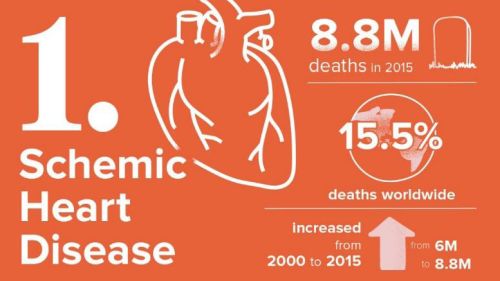
The deadliest disease in the world is coronary artery disease. Also called ischemic heart disease. It occurs when the blood vessels that supply blood to the heart become narrowed. Untreated, can lead to chest pain, heart failure, and arrhythmias.
Risk factors for ischemic heart disease include:
- high blood pressure
- high cholesterol
- smoking
- family history of ischemic heart disease
- diabetes
- being overweight
You can prevent coronary artery disease with medications and by maintaining good heart health. Some steps you can take to decrease your risk include:
- exercising regularly
- maintaining a healthy weight
- eating a balanced diet that is low in sodium and high in fruits and vegetables.
- avoiding smoking
- drinking only in moderation
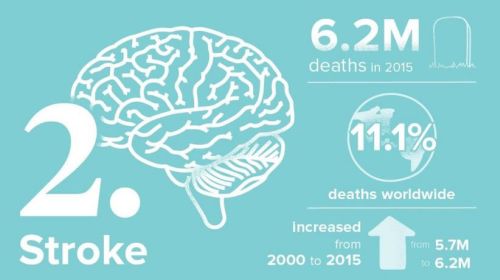
A stroke occurs when an artery in your brain is blocked or leaks. This causes the oxygen-deprived brain cells to begin dying within minutes. During a stroke, you feel sudden numbness and confusion or have trouble walking and seeing. If left untreated, a stroke can cause long-term disability.
Risk factors for stroke include:
- high blood pressure
- family history of stroke
- smoking, especially when combined with oral contraceptives.
- being female
Stroke prevention methods may include controlling high blood pressure with medications. You should also maintain a healthy lifestyle, complete with regular exercise and a healthy diet that is low in sodium. Avoid smoking, and drink only in moderation.
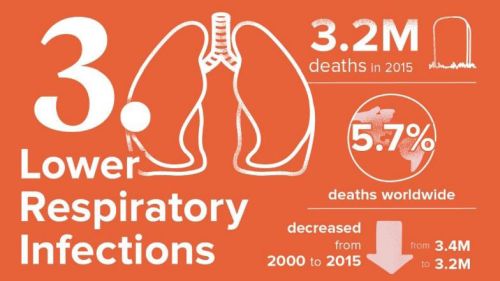
A lower respiratory infection is an infection in your airways and lungs. It can be due to: influenza, or the flu, pneumonia, bronchitis or tuberculosis.
Viruses usually cause lower respiratory infections. They can also be caused by bacteria. Coughing is the main symptom of a lower respiratory infection. You may also feel breathlessness, wheezing, and a tight feeling in your chest. Untreated lower respiratory infections can lead to breathing failure and death.
Risk factors for lower respiratory infection include:
- the flu
- poor air quality or frequent exposure to lung irritants
- smoking
- a weak immune system
- crowded childcare settings, which mainly affects small children.
- asthma
- HIV
One of the best preventative measures you can take against lower respiratory infections is to get the flu shot every year. People at high risk of pneumonia can also get a vaccine. Wash your hands regularly with soap and water to avoid transmitted bacteria, especially before touching your face and before eating. Stay at home and rest until you feel better if you have a respiratory infection, as rest improves healing.

Chronic obstructive pulmonary disease (COPD) is a long-term, progressive lung disease that makes breathing difficult. Chronic bronchitis and emphysema are types of COPD.
Risk factors for COPD include:
- smoking or second-hand smoke
- lung irritants like chemical fumes
- family history
- history of respiratory infections as a child
There is no cure for COPD, but its progression can be slowed with medication. The best ways to prevent COPD are to stop smoking and to avoid second-hand smoke and other lung irritants.
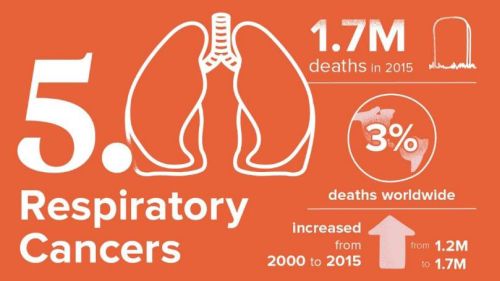
Respiratory cancers include cancers of the trachea, larynx, bronchus, and lungs. The main causes are smoking, second-hand smoke, and environmental toxins. But household pollutions such as fuels and mould also contribute.
Risk factors and prevention:
Trachea, bronchus, and lung cancers can affect anyone, but they are most likely to affect those who have a history of smoking or tobacco use. Other risk factors for these cancers include family history and exposure to environmental factors, such as diesel fumes.
Aside from avoiding fumes and tobacco products, it is not known if there is anything else that can be done to prevent lung cancers. However, early detection can improve your outlook and reduce the symptoms of respiratory cancer.

Diabetes is a group of diseases that affect insulin production and use. In type 1 diabetes, the pancreas cannot produce insulin. The cause is not known. In type 2 diabetes, the pancreas does not produce enough insulin, or insulin cannot be used effectively. Type 2 diabetes can be caused by a number of factors, including poor diet, lack of exercise, and being overweight.
Risk factors for diabetes include:
- excess body weight
- high blood pressure
- older age
- not exercising regularly
- an unhealthy diet
While diabetes is not always preventable, you can control the severity of symptoms by exercising regularly and maintaining good nutrition. Adding more fiber to your diet can help with controlling your blood sugar.
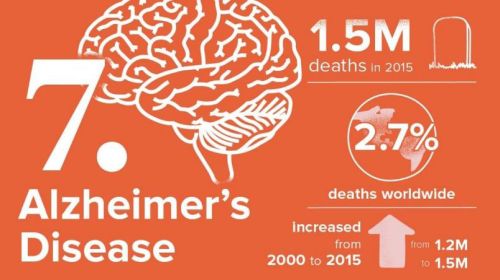
When you think of Alzheimer’s disease or dementia, you might think of a loss of memory, but you might not think of a loss of life. Alzheimer’s disease is a progressive disease that destroys memory and interrupts normal mental functions. These include thinking, reasoning, and typical behaviour.
Risk factors for Alzheimer’s disease include:
- being older than 65
- a family history of the disease
- inheriting genes for the disease from your parents
- existing mild cognitive impairment
- Down syndrome
- unhealthy lifestyle
- being female
- previous head trauma
- being shut off from a community or having poor engagement with other people for extended periods of time
There is not currently a way to prevent Alzheimer’s disease. Researches are not clear why some people develop it, and others do not. As they work to understand this, they are also working to find preventive techniques.
One thing that may be helpful in reducing your risk of the disease is a heart-healthy diet. A diet that is high in fruits and vegetables, low in saturated fats from meat and dairy, and high in sources of good fats like nuts, olive oil, and lean fish may help you reduce your risk of more than just heart disease — they may protect your brain from Alzheimer’s disease, too.
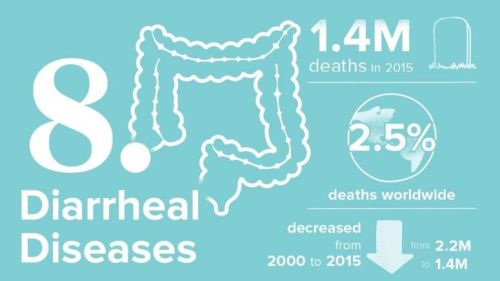
Diarrhoea is when you pass three or more loose stools in a day. If your diarrhoea lasts more than a few days, your body loses too much water and salt. This causes dehydration, which can lead to death. Diarrhoea is usually caused by an intestinal virus or bacteria transmitted through contaminated water or food.
Risk factors for diarrheal diseases include:
- living in an area with poor sanitary conditions
- no access to clean water
- age, with children being the most likely to experience severe symptoms of diarrheal diseases.
- malnourishment
- a weakened immune system
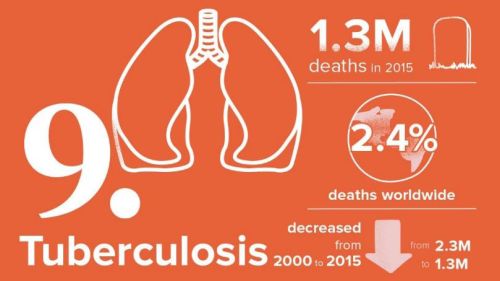
Tuberculosis (TB) is a lung condition caused by bacteria called Mycobacterium tuberculosis. It is a treatable airborne bacterium, although some strains are resistant to conventional treatments.
Risk factors for tuberculosis include:
- diabetes
- HIV infection
- a lower body weight.
- proximity to others with TB
- regular use of certain medications like corticosteroids or drugs that suppress the immune system.
The best prevention against TB is to get the bacillus Calmette-Guerin (BCG) vaccine.
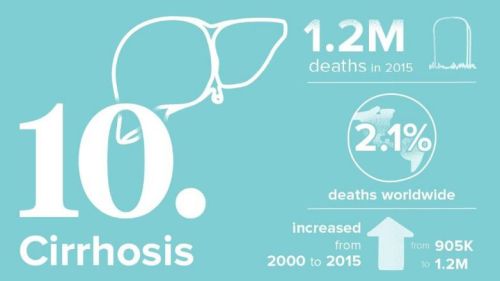
Cirrhosis is the result of chronic or long-term scarring and damage to the liver. The damage may be the result of a kidney disease, or it can be caused by conditions like hepatitis and chronic alcoholism. A healthy liver filters harmful substance from your blood and sends healthy blood into your body. As substances damage the liver, scar tissue forms. As more scar tissue forms, the liver has to work harder to function properly. Ultimately, the liver may stop working.
Risk factors for cirrhosis include:
- chronic alcohol use
- fat accumulation around the liver (non-alcoholic fatty liver disease)
- chronic viral hepatitis
Stay away from the behaviours that can lead to liver damage to help prevent cirrhosis. Long-term alcohol use and abuse are one of the leading causes of cirrhosis, so avoiding alcohol can help you prevent damage. Likewise, you can avoid non-alcoholic fatty liver disease by eating a diet that is healthy, rich in fruits and vegetables, and low in sugar and fat. Lastly, you can reduce the likelihood of contracting viral hepatitis by using protection during sex and by avoiding sharing anything that could have traces of blood. This includes needles, razors, toothbrushes, and more.
Positive lifestyle changes
Getting the Right Amount of Sleep - A good night's sleep is important to recharge the proverbial "batteries." It also attends to all of the metabolic functions required by the body, such as regenerating old cells, getting rid of wastes, and repairing cell damage. Sleep is also important in making memories, and sleep deprivation leads to forgetfulness.
Even if you intend to sleep well, medical conditions can sometimes interfere, like Sleep apnoea. Changes in your sleep patterns can also be a sign of a change in your health, so see your doctor for a check-up if anything changes.
Eating Well-Balanced Meals - A healthy, balanced diet can help provide energy and lower your risks for the leading chronic diseases such as heart disease, hypertension, diabetes, and cancer. It can also help you maintain a normal weight. Certain diseases or conditions have proven relationships with specific nutrition or dietary elements.
Engaging in Regular Physical Activity - Thirty minutes a day of regular physical activity contributes to health by reducing heart rate, decreasing the risk for cardiovascular disease, and reducing the amount of bone loss that is associated with age and osteoporosis.
Once you are past age 65, the requirements do not go down, and you may benefit by adding balance exercises and flexibility exercises.
Maintaining a Healthy Body Weight - There is not any real magic when it comes to maintaining (or getting to) a normal body mass index. Eating a healthy diet (not too much and avoiding empty calories) and exercising daily (even if it is fun activities such as gardening) is the true "secret."
If you are struggling, talk with your doctor. But keep in mind that fad diets do not work, and your greatest chance of success lies in adopting long-term healthy eating patterns and engaging in regular physical activity for life.
Not Smoking or Chewing Tobacco - If you want to live an enjoyable life for however long you live, do not smoke or chew tobacco. The list of diseases and cancers attributed to smoking is long, but sometimes long-range concerns prompt less change than immediate concerns.
Limiting or Avoiding Alcohol - Alcohol should be consumed only in moderation, and for many people, not at all. Moderate alcohol consumption is defined as one drink for women, two for men per day.
Higher levels of alcohol can lead to health and behavioural problems, including an increased risk for high blood pressure, stroke, heart disease, some cancers, accidents, violence, suicide, and deaths in general.
Sources:
https://www.who.int/en/news-room/fact-sheets/detail/the-top-10-causes-of-death
https://www.verywellhealth.com/lifestyle-factors-health-longevity-prevent-death-1132391

